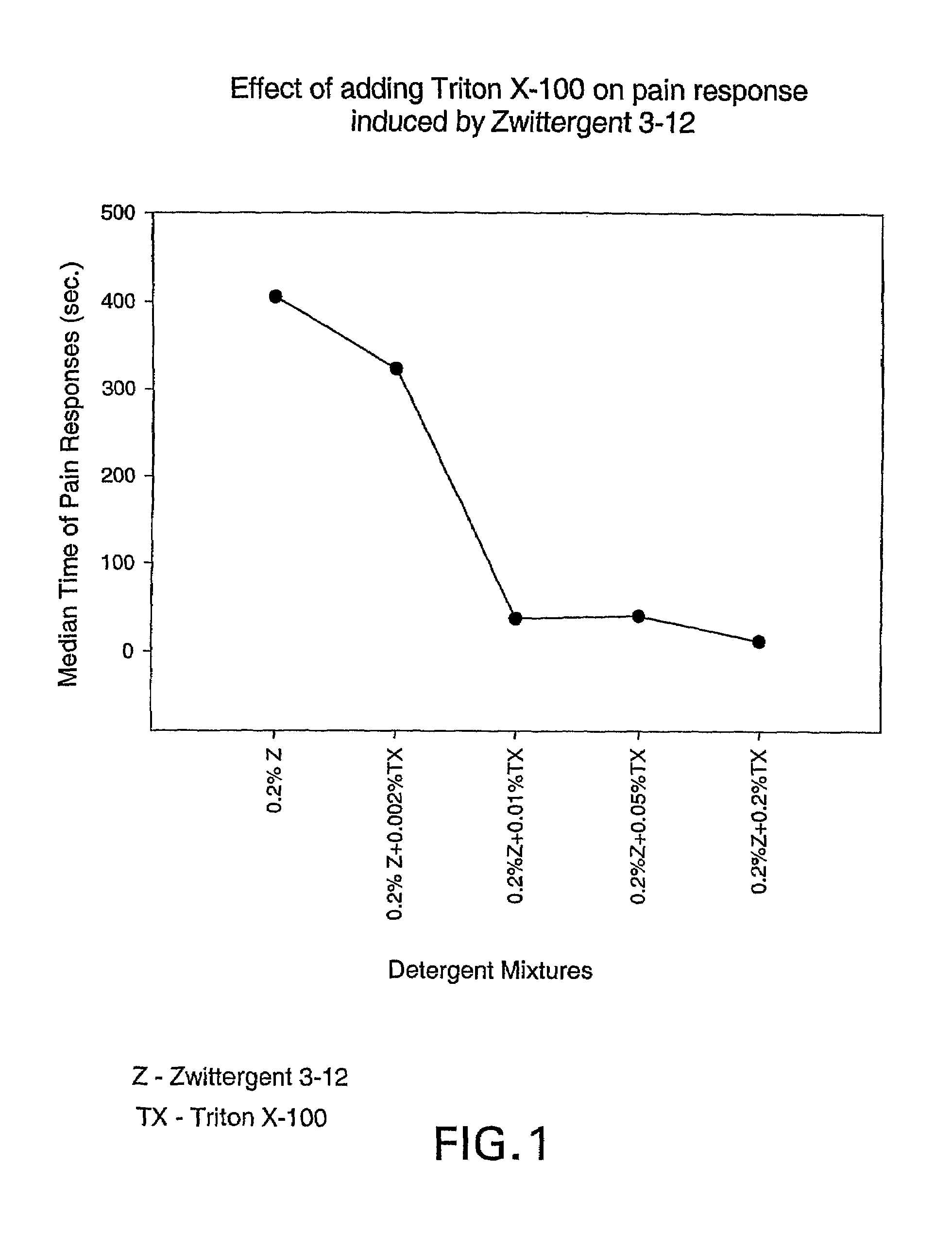Formulations of hydrophobic proteins in an immunogenic composition having improved tolerability
a hydrophobic protein and immunogenic composition technology, applied in the field of nonpainful or lesspainful immunogenic and pharmaceutical compositions, can solve the problems of sporadic and epidemic diseases, denatured proteins and proteins in mixed micelles are generally not optimal for use as immunogenic compositions, and mild detergents are often not able to solubilize certain hydrophobic membrane proteins
- Summary
- Abstract
- Description
- Claims
- Application Information
AI Technical Summary
Benefits of technology
Problems solved by technology
Method used
Image
Examples
example 1
Pain Responses to Injection of Various Immunogenic Compositions
Materials and Methods
[0088]Immunogenic composition preparation. Recombinant gonococcal PorB (“GC rPorB” from N. gonorrhoeae strain FA1090) was produced in E. coli using the pET-17b expression vector (Novagen, Inc., Madison, Wis.). The recombinant protein, which was expressed in inclusion bodies, was solubilized in urea and purified by column chromatography in Zwittergent® (“Zw”) 3-14 under current good manufacturing practice (cGMP). The batch concentrate material was stored in 10 mM NaPO4 (pH 7.4), 150 mM NaCl and 0.05% (w / v) Zw 3-14 (Calbiochem, San Diego, Calif.; cat. #693017) at −20° C. The protein concentration of this material was 1.3 mg / ml.
[0089]All buffers used in the immunogenic compositions tested in the rat footpad pain model were prepared using water for injection (“WFI”) and were passed through a 0.22 μm membrane filter. Reduced TRITON® X-100 (“red TX”) was obtained from Sigma (St. Louis, Mo.; cat. #X-100R-PC...
example 2
Effect of Injection Volume on Pain Responses
Materials and Methods
[0106]Immunogenic composition preparation. Immunogenic compositions were prepared as described in Example 1. To increase the sensitivity of this model, the maximum injection volume for this model (0.2 ml) was evaluated. In this example, the PBS was pyrogen-free.
[0107]Rat footpad pain testing. Rat footpad pain testing was performed as described in Example 1. In this example four to six animals were in each group, and 0.1 ml and 0.2 ml injection volumes were used.
[0108]Statistical analysis. Statistical analysis was performed as described in Example 1.
Results
[0109]Table 3 summarizes the effect of injection volume (0.1 ml compared to 0.2 ml) on pain responses. The median, mean and range of the length of time spent on pain responses are given for each immunogenic composition group for each post-treatment period of observation. Note, 0.1×GC rPorB=10 μg / ml GC rPorB and 1×GC rPorB=100 μg / ml GC rPorB. Table 4 summarizes the sta...
example 3
Pain Responses on Injection of Immunogenic Compositions
Materials and Methods
[0114]Immunogenic composition preparation. Immunogenic compositions were prepared as described in Example 2. The PFP-2+QS-21 immunogenic composition, which is associated with pain upon injection in human volunteers, was used as a positive control.
[0115]Rat footpad pain testing. Rat footpad pain testing was performed as described in Example 1. In this Example, eight animals were in each group, and 0.2 ml injection volume was used.
[0116]Statistical analysis. Statistical analysis was performed as described in Example 1. In addition, a comparison of all three groups to each other was done using the rank-transform ANOVA approach with Tukey-Kramer adjustment for multiple comparisons.
Results
[0117]This study was performed to test whether the immunogenic composition PFP-2+QS-21 might serve as a positive control because it is associated with pain upon injection in human volunteers. These immunogenic compositions, exce...
PUM
| Property | Measurement | Unit |
|---|---|---|
| volume | aaaaa | aaaaa |
| pH | aaaaa | aaaaa |
| concentration | aaaaa | aaaaa |
Abstract
Description
Claims
Application Information
 Login to View More
Login to View More - R&D
- Intellectual Property
- Life Sciences
- Materials
- Tech Scout
- Unparalleled Data Quality
- Higher Quality Content
- 60% Fewer Hallucinations
Browse by: Latest US Patents, China's latest patents, Technical Efficacy Thesaurus, Application Domain, Technology Topic, Popular Technical Reports.
© 2025 PatSnap. All rights reserved.Legal|Privacy policy|Modern Slavery Act Transparency Statement|Sitemap|About US| Contact US: help@patsnap.com

